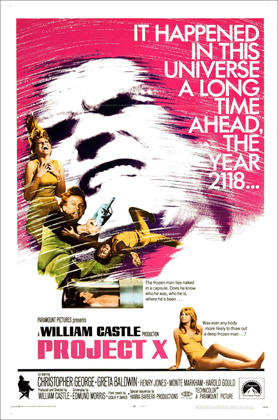
“We were waiting for you, Hagan. You’re a living, breathing bomb of death—set to go off in fourteen days…”
Director: William Castle
Starring: Henry Jones, Christopher George, Harold Gould, Phillip Pine, Monte Markham, Lee Delano, Ivan Bonar, Robert Cleaves, Greta Baldwin, Sheila Bartold, Keye Luke
Screenplay: Edmund Morris, based upon two novels by Leslie P. Davies
Synopsis: The year is 2118. Dr Crowther (Henry Jones) shows the cryogenically preserved body of geneticist and historian, Hagan Arnold (Christopher George), to Colonel Holt (Harold Gould), the Head of Security. Holt demands that Arnold be brought back to life, and when Crowther protests, reminds him of the imperative need to understand the final message transmitted by Arnold before his plane crashed. Sent out of the meeting for security reasons, Dr Lee Craig (Phillip Pine) and nurse Sybil Dennis (Sheila Bartold) discuss Arnold’s mission; Craig reveals that team that Arnold was sent into Sino-Asia to investigate a rumour that the Sinoese had found a way of mass producing male babies, and that he apparently discovered something else as well. Meanwhile, although Crowther tells Holt that even if they succeed in reviving Arnold, he will have no memory, he admits that there might be a way of tapping into Arnold’s subconscious to obtain the information they need. Holt insists that Crowther and his team of scientists begin work at once, informing them that Arnold’s message indicated that the Western world would be destroyed in fourteen days—four of which have already passed. As the team discusses how to proceed, Dr Tony Verity (Lee Delano), a behavioural scientist, tells the others that, once revived, Arnold needs to be kept in one place, yet not put under restraint. He suggests making Arnold believe that he has committed a crime, and must hide out. When Craig objects that crime was eliminated generations earlier, Verity reminds the team that Arnold was an historian specialising in the 1950s and 1960s. A new identity is chosen for Arnold: that of “Alan Fraser”, killed during a bank robbery in 1968. Crowther announces that a new matrix, or personality, will be fed into Arnold’s subconscious, giving him just enough information to function. Holt is told that a new environment will need to be built, one that replicates the conditions of 1968. When the site has been prepared, and Arnold given his matrix and dressed appropriately, he is woken from his state of unconsciousness by gunshots and sirens. Lee Craig, posing as a member of the gang, drags “Fraser” towards their farmhouse hideout. Arnold is bewildered, but responds instinctively to Craig’s urgency. At the farm, Craig introduces Arnold to “Doc Crowther”, the supposed owner of the house, and to Sybil Dennis, who is posing as Craig’s wife. Although Arnold has no clear memory of any of the people in the house, he tries to conceal it. The men have a drink. Unbeknownst to Arnold, his is drugged. When the sedative takes effect, electrodes are attached to Arnold’s head. In a laboratory adjacent to the farmhouse, Dr George Tarvin (Robert Cleaves) starts his laser hologram equipment, via which images can be sent into the human brain, or images from the brain received and recorded. Crowther and his team hope that by sending Arnold’s subconscious images of what transpired before he left for Sino-Asia, they will be able to stimulate his memory to recall the information that may decide the fate of the Western world…
Comments: Though it tends to get overlooked amongst William Castle’s better-known (and more huckster-ish) films, I have a lot of time for Project X—even though I can’t in conscience call it good; interesting, certainly. The producer-director’s only straight science fiction outing, this is a film that wraps some serious political commentary within layer upon layer of cheese, at the same time – in typical Castle fashion – making a virtue out of its various limitations.


As I have observed elsewhere, 1968 was a remarkable year for cinematic science fiction, as film-makers reacted to social change and political upheaval worldwide with a plethora of imaginative cautionary tales. While it is hardly surprising that Project X gets lost in the shadows cast by productions such as 2001 and Planet Of The Apes – it was released on the bottom half of a double-bill with Barbarella and attracted little notice – thematically it deserves a seat at the same table as its big-budget competition.
Adapted by Edmund Morris from two novels by L. P. Davies, The Artificial Man and Psychogeist, the film plays an interesting double-game, frankly denouncing the time period in which it was made, but simultaneously scattering around enough clues to the story’s “present” to allow viewers to piece together a disturbing image of the society in which the story is unfolding.
Yet serious as the film’s core certainly is, it is almost possible to completely lose sight of the fact thanks to the level of visual distraction provided by the production’s costuming, art direction and special effects. It is impossible not to see the fingerprints of Star Trek all over Project X, from its parti-coloured but completely impractical design to the world’s most uncomfortable leisure-wear to the endless techno-babble via which the story’s science is conveyed to the viewer. It’s difficult to focus on a terrifying vision of the future when this requires dragging your attention away from the see-through plastic helmets favoured by the military. And as with the original Trek, whether or not you enjoy Project X may depend upon your capacity to see past the surface tackiness to the ideas working beyond.
(Apropos, we note that while alcohol is apparently still in existence in 2118, at one point a character does indulge in synthotine.)

“Here at the State Department, we are not simply colourless bureaucrats…”
The most spectacular distraction, however, is the animation used to realise the memories of Hagan Arnold, which (as anyone of the right age will recognise instantly) was the work of Hanna-Barbera. As so often, William Castle’s ideas were much bigger than his budget, and his efforts to visualise the workings of a man’s subconscious, with standard animation supplemented by a variety of optical tricks including solarisation and negative- and double-exposure, are completely inadequate, albeit rather charmingly so—or so we may feel now. Alas, it seems that these show-stopper sequences were largely responsible for the failure of Project X at the time of its initial release: audiences that embraced the psychedelia of 2001 hooted poor Bill Castle’s efforts off the screen.
At any rate, Project X lets us know from its first moments what we’re in for, with the credits appearing against brightly animated backgrounds that simultaneously do that “squares flickering in and out” thing that at the time was so often used as shorthand for computers, before we fade to our next visual signifier, a line of pink lights that pulse and blip for no reason at all. These turns out to be in an elevator, whose doors slide open with the Trek-“swish”.
The elevator releases its passengers into a large, otherwise empty storage facility, which is covered with circles that turn out to be the ends of storage canisters embedded in its walls. Scientist Dr Crowther crosses to one, flipping open a panel to reveal the name “Hagan Arnold”, and presses a number of switches; his companions from the elevator push a trolley towards him, and the three pull the canister onto it.
The elevator then disgorges another group of people, two of them clearly military. The single woman of the gathering, nurse Sybil Dennis, presses a button and part of the canister slides back, revealing with a man.

“I suppose I should try to be a little less negative.”
Colonel Holt orders Crowther and his team to get to work immediately, only for Crowther to insist (in a weary voice which suggests they’ve had this conversation, or one like it, many times before) that what he is asking is impossible. When Crowther’s right-hand man, Dr Lee Craig, further explains that, “Once the psycho-barrier was been activated, you cannot restore memory”, Holt demands to know if they’ve ever tried?—and you’ve never heard an eye-roll so clearly translated into a tone of voice as when Crowther replies drily, “Yes, we have.”
“Then try again!” is the inevitable rejoinder, which has the effect of making Crowther send Lee Craig and Sybil Dennis out of the room, so that he can talk privately to the military men. We stay with the other two for the moment, though, and get another intimation of the structure of this futuristic society when Sybil wonders out loud what the Head of Security is doing in their facility. The subsequent conversation both sets up the plot and offers the first of the film’s loopy science: we learn that Hagan Arnold had been sent on a secret mission into “Sino-Asia”, where he was able to confirm the worrying rumour that the Sinoese have found a way of “mass producing” male babies.
As with a number of films produced at this time, Soylent Green being the most famous, the spectre of overpopulation haunts the background of Project X—although while producing children of only one sex is one way to lower the birth rate, the overt threat here is clearly one of armies of limitless proportions. Also in common with various science fiction films of this era (and, ahem, Star Trek), Project X offers an amusing, and sometimes exasperating, mixture of forward-thinking and mired-in-the-present, particularly with respect to the position of women in this “futuristic” society and the unthinking sexism that underlies their depiction. At the same time, this aspect of the film is one of its most disturbing. It becomes evident that on both sides of the world’s new political divide, the government is in charge of the reproduction of its people; as we shall later learn, “the West” is pursuing a policy of controlled child-bearing different from but no less outrageous than that of the bad-guy Sinoese.
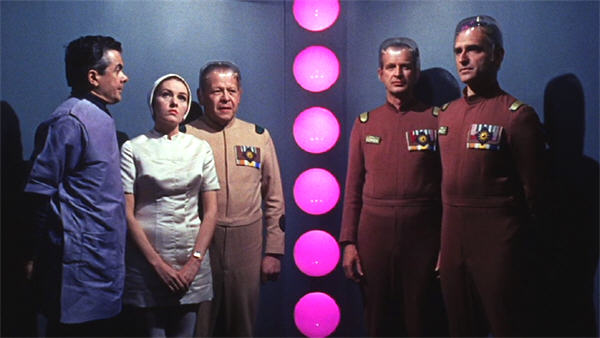
Awkward elevator silences of…THE FUTURE!!
And of course, the other fascinating touch here is that there is no mention of the Soviet Union in this film. We are left to work out for ourselves just who has been absorbed into Sino-Asia, and how, with little more evidence at our disposal than a curiously inaccurate-seeming map of Asia and the fact that the leader of this new world power is Chinese.
Lee Craig adds that after Hagan Arnold confirmed the baby rumour, he apparently stumbled onto “something bigger”. That bigger thing, we learn, is that the Sinoese have a new super-weapon, and that as a consequence, the West will be destroyed in fourteen days…
So Arnold said in his final transmission before his plane crash-landed, and he was put into cryogenic storage, and hence the urgent need for Crowther and his team not merely to resurrect him – they can do that without difficulty – but to restore his memory, which has been wiped.
In the course of his ongoing argument with Holt, Crowther speculates that the memories that the government needs might well still be present in Arnold’s subconscious. Holt leaps upon this, ordering those memories accessed—and within the next ten days, since four have already been wasted in political argument over Arnold’s message. Crowther is exasperated and pessimistic, but recognises that they have no choice but to try and find a way.
Its science vs the military plot is one of its most interesting aspects of Project X, and not just because it is through the clash of Crowther and Holt that we gain much of our understanding about the state of the society in which both are functioning. While in the context of the story the scientists are certainly positioned as the good guys (or at least, the better guys), there is no question that they are operating throughout in shades of grey—some of them bordering on black. Any number of moments might elicit from the viewer a gasp of dismay; the “brain-squeezing” with which the film ends – which is, in fact, offered as its happy ending – is frankly horrifying.
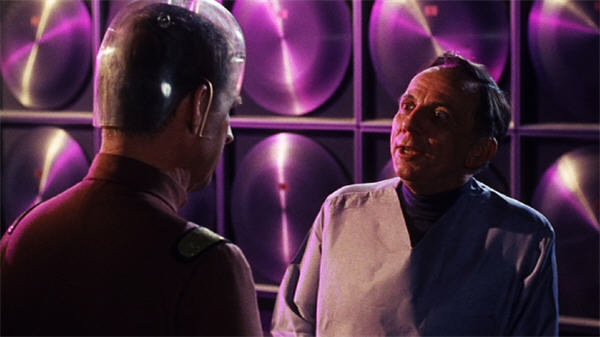
“I know you’re trying to hide your thoughts from me, Colonel, but I can see right through you!”
Granted, the stakes are extraordinarily high; and it becomes increasingly clear that these scientists have little autonomy, being instead, like (we gather) the rest of their society, subject to control by a military government. Perhaps Crowther’s verbal objections are as much as we have any right to expect, under the circumstances.
Christopher George as Hagan Arnold gets billing in Project X, reasonably enough, although truthfully the part requires little more than a square jaw and a bewildered expression. Greta Baldwin’s co-star billing is, however, distinctly questionable, since her character is just a throwaway bit of eye-candy (tokenism of…THE FUTURE!!); although that said, the fact that she was cast purely for her physical attributes is ironically appropriate, as we shall see. A former model, Baldwin was the then-girlfriend of the head of Paramount, and William Castle had her thrust upon him, so to speak.
However, as is so often the case, the real star of Project X is found lurking in the first “also starring” slot. Henry Jones steals the film with his off-kilter performance as Dr Crowther, which was probably his way of dealing with the silliness in which he found himself involved, but which adds an edge to proceedings that is simultaneously comical and a bit worrying. It is too much to say that Crowther is mad, but there is certainly something up with his marbles—a few too many, rather than too few, we feel. His affect is all over the place; he grins broadly when things are at their worst. Though we are encouraged to side with the scientists, there are moments when you almost feel for Holt and his colleague, Colonel Cowen, as they have to deal with Crowther and his alarmingly bright eyes.
Holt, in fact, leaves Cowen behind to do just that, and this allows some exposition about the cryogenic process, which is mostly used for the planned preservation of important individuals, in the hope of a future cure for what ails them and an extension of their lives. The normal process involves recording as much information as possible about an individual’s life, interests and personality as possible beforehand, with the aim of restoring those memories if necessary when they are revived. Moreover, “cells and tissues” (or whatever the hell that is in Crowther’s little storage box) are removed and stored, in case physical repair is needed.
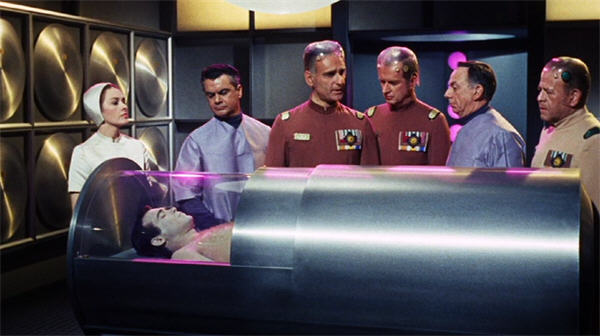
“Unfortunately, we failed to anticipate the outbreak of ‘Christopher George in a can’ jokes.”
But Hagan Arnold (as we discover later) was not one of those chosen a priori for cryogenic preservation, and consequently none of this material is available to the scientists. Instead, Crowther and his team have to figure out how to awaken the memories that are stored in Arnold’s subconscious, and as quickly as possible.
Not to mention as cheaply as possible.
Crowther and his team meet to discuss how to proceed, with Cowen laying the situation out for them. Although East and West agree that “thermo-nuclear war is out of the question”, it is taken for granted that whichever side comes up with an alternative, less generally destructive super-weapon will finally dominate the world. The military’s belief is that Hagan Arnold discovered, firstly, that the Sinoese have such a weapon, secondly, what it is, and mostly importantly, when and how they plan to use it. With a mere ten days left, the scientists must access Arnold’s subconscious.
It is revealed that all agents sent into Sino-Asia are first injected with a serum which activates if an individual is subjected to “extreme pain”—captured and tortured, in other words—and which wipes that person’s memory. Where this has happened, the scientists are able to give that person a new personality, new memories, a new life; trying to recovery the pre-existing memories is, however, a whole new ballgame.
The idea of imposing a personality, real or false, upon a resurrected individual, which originated in the novels by L. P. Davies on which the film is based, is one of its most interesting touches—not least because the term used for these artificial personalities is “a matrix”.
We learn that the “brilliant” Arnold qualified as a geneticist (hence his recruitment for the mission to Sino-Asia) before turning his attention to history, his specialty being – surprise! – the 1950s and 1960s.
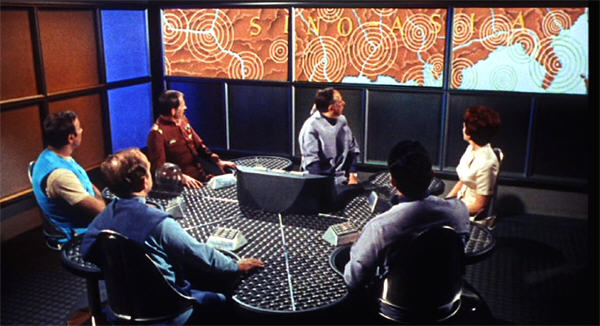
“I’m reasonably sure this map is complete, yes.”
Behaviourist Tony Verity comments that they will need to find a way of keeping the revived Arnold in one place, where they can get at him whenever necessary, but without keeping him under restraint. As an idea occurs to him, he wishes out loud that he knew more about the 1960s, Arnold’s area of expertise. Project X then gets in a few contemporary licks as, while the scientists look on aghast, Crowther shows them images of the time—a fair proportion of which consists of real news footage of demonstrations being violently broken up by the police and the MPs.
(Curiously, though, there are also scenes that look like clashes between blackshirts and protesters in England in the 1930s. Definitely English, anyway.)
When Verity proposes keeping Arnold in one place by making him believe he has committed a crime, Lee Craig protests that “crime” and “violence” were eliminated three generations ago (super-weapons capable of destroying half the world aside, that is). Verity agrees—adding that they will need to create an artificial environment that will convince Hagan Arnold that he is living in—oh, let’s say 1968…
The other problem is that they don’t want to give Arnold too much of a new personality—just enough information to keep him functioning, while severing his old life from his new situation. The scientists find “a matrix” for Arnold to inhabit temporarily by scrolling through a series of newspaper front pages of 1968, to the accompaniment of more jaw-dropping—
Dr Crowther: “You’ve just had a glimpse of what’s known as ‘the good old days’.”
—that of Alan Fraser, shot dead during the commission of a bank robbery. Crowther tells Cowen that the military must build, as quickly as possible, an isolated farmhouse perfect in every historical detail. (And if they manage to do it so that it looks just like a tacky set in a low-budget movie, all the better!)
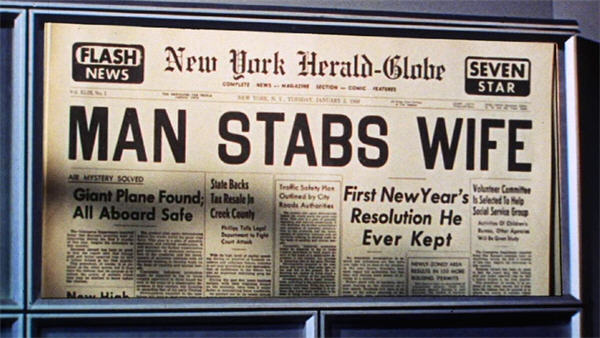
Boom-tish.
[Naturally I’m more interested in the story to the left…]
Another interesting but unexplained touch in this film is the complete disconnect between the present and the not-too-distant past: most people seem to have no knowledge of how things were before—well, whatever happened, happened. (The overpopulation issue would seem to eliminate the usual suspect, WWIII.) The film’s budget didn’t extend to showing us how things are in the far-flung future of 2118; instead, during the recreation of 1968, characters repeatedly express bewilderment over what we might consider the most common details of life.
Actually— I say “characters”, but this thankless task invariably falls to Sybil Dennis as the one girl in the clubhouse, and to an extent that makes her seem – to put it as gently as possible – rather dull-witted. Indeed, her complete befuddlement over a mysterious entity from the past known as a “po-ta-to” nearly brings the whole recreation plot crashing to the ground. (No, really.) However, in this way and others the fact that humanity has moved on t0 that most beloved invention of science fiction writers, “the food pill”, is made evident.
The military springs into action, rapidly constructing the lonely farmhouse that is to be the hideout of Alan Fraser and his gang, and decorating it with “artefacts” borrowed from various museums. A revived Hagan Arnold, his new matrix implanted, comes out of a drugged state to the alarming sound of police sirens and gunshots, and someone he doesn’t know addressing him as “Alan” while he urges him into a run. Arnold responds instinctively, and finds himself in a beaten-up building deep in the countryside surrounded by people who seem to know him, though he recognises none of them, nor his whereabouts; his incomplete memories suggest that something is badly wrong, but in the face of his companions’ insistence on “lying low” he can only obey—for the present.
(The other scientists “play” the gang, in between monitoring Arnold and manipulating his situation from rooms built into the “farmhouse”. The farm is supposedly owned by a disreputable individual called “Doc Crowther”—with Henry Jones offering an amusing riff on his character from The Bad Seed.)

Henry Jones: method actor.
About this time, we begin to see a bearded individual wearing, ahem, “futuristic” clothing out of place in the 1960s setting lurking in the bushes, spying on the farmhouse…
Arnold is given a drugged drink, and as soon as he is unconscious, Crowther attaches a set of electrodes to his head. The scientists are to begin by transmitting images – holograms, no less – into Arnold’s mind, via the use of a laser. These are recreations of what they know did happen to him: their hope is that if they do this successfully, eventually it will trigger recall of what they don’t know. The electrodes are attached to a computer with a large screen, on which the scientists are able to watch and record what is going on in Arnold’s subconscious…
It sure is bright and colourful in there.
This is where the animations effects kick in, of course, with a psychedelic rendering of Hagan Arnold’s mind which persists all the way through the film’s backstory, starting now with his recruitment by the State Department. Most of what we already know about Arnold’s mission is reiterated here (mostly in shades of blue and orange), with the additional detail that a previous agent, Gregory Galleia, disappeared in Sino-Asia two years earlier. We also see Arnold being injected with the memory-wiping serum.
Crowther stops this first venture, emphasising to his people that more than four minutes at a time of such transmitted memories could cause brain damage.
The next morning, the telephone rings while Sybil Dennis’s powerful intellect is wrestling with the concept of stem vegetables. Against orders, she has left the house to go searching for someone who can explain potatoes to her, so Arnold answers it. The caller identifies himself as Gregory Galleia, which triggers a reaction in Arnold. He tries to make a break for it, only to be jumped and knocked out by two of his “friends”—which gives Crowther the chance to pump more memories into him…
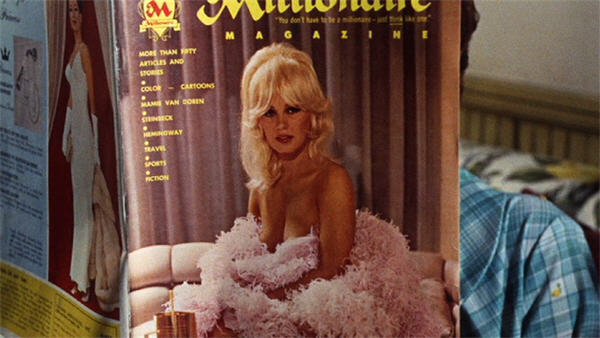
I wonder which museum provided that “artefact”?
[March 1966, if you’re interested.]
This time around we follow Arnold as he penetrates Sino-Asia by submarine, and proceeds to infiltrate the territory’s medical system after disguising himself by putting on a hat.
No, really.
(It would be helpful to know whether or not Caucasians are a rarity in Sino-Asia.)
Meanwhile, the scientists confront Cowen over the phone-call, warning him that whether it was actually Galleia or not, Arnold’s matrix is being threatened. That night, a second call from “Galleia” warns Arnold that his life is in danger, that he has to get away… Despite further warnings from “the gang” about the police in the area, Arnold makes a second break. This time he gets some distance cross-country, and encounters an attractive (if rather vacuous) blonde, whose conversation further challenges what his other companions are telling him about his reality. It also gives the viewer more information about the rigid formality of “the future”, with jobs assigned and disciplinary action taken against those who “disobey orders”. The girl, Karen Summers, is just expressing puzzlement over the farmhouse – “These buildings are from ages ago!” – when the conversation is broken up by a shot from a laser-gun, striking nearby, fired by the bearded lurker. Karen screams and flees, leaving Arnold to make his own panicked way back to the farmhouse—where he runs straight into a staged “cop shooting” meant to dissuade him from leaving the house again.
The scientists detected that Arnold had met with someone, and Karen is rounded up for questioning by Colonel Cowen. Her answers bring only new problems, and she is detained. Sybil Dennis escorts her to her assigned room, and one of the film’s most worrying moments follows as, after an admiring glance, Sybil comments on how pretty Karen is, then asks if she is “a sterrie”.
“No,” responds Karen, looking unbearably smug, “I am permitted to have two children, when I get married.”

Hagan Arnold’s impenetrable disguise allowed him to infiltrate Sino-Asia…
A world of disturbing implications is wrapped up in that single sentence, and made even worse by the fact that the more we see of Karen, the more evident it becomes that her only qualification for breeding is her physical attractiveness.
Still worried about the Galleia factor, and not confident that the military aren’t jerking them around, Crowther and Craig do their own investigation, learning of Arnold’s first transmission message – “Sinoese solve secret of chromatin in nucleus of cells”, although I’m not sure what’s so secret about that – the two-month disappearance that made the West give him up for dead, and the fact that when his plane appeared on radar after his escape, he reported a co-pilot—but when the plane was found, he was alone.
By this time it is perfectly clear that Lurking Beardo is Gregory Galleia, and we see him next breaking into the “secure” area where Karen is being held. After activating a signal-blocker that allows them to talk without being detected, Galleia tells Karen that Hagan Arnold, aka Alan Fraser, is in danger of his life because of a secret he learned in Sino-Asia—that secret being that Sen Chiu, the leader of the Sinoese, and Dr Crowther are in league to destroy the West, and that Crowther’s “memory” experiments are a cover for the destruction of Arnold’s mind. And of course, he’ll have to get rid of Karen too…
A dead guard in the secure facility brings Holt hurrying back from “the Capital”, just in time for the conclusion of the transfer of recreated memories into Arnold’s mind, and the first attempt at accessing his own. Crowther tries to dissuade him, but Holt insists on sitting in, much to the scientists’ dismay. After a few nervous moments, Arnold responds to the new stimulation, and his experiences in Sino-Asia begin to play out onscreen…
…and a thirteen-minute special effects extravaganza follows—provided, that is, you don’t over-interpret “extravaganza”.
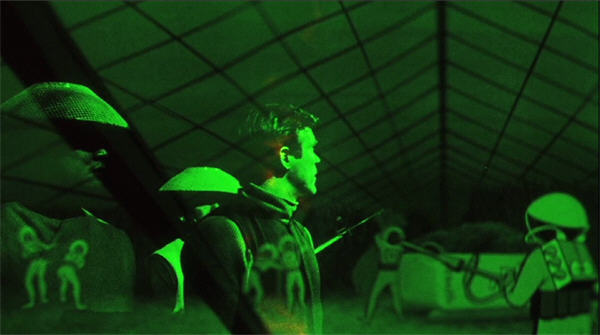
“Excuse me, could you tell me where I might find Jonny Quest?”
In any event, the story then becomes Hagan Arnold’s own, from his capture by the Sinoese, his confrontation with Sen Chiu, his rescue from imprisonment by – gasp! – Gregory Galleia, and the men’s escape by plane. The effects vary throughout, from straight animation to various bits of optical trickery, keeping this otherwise standard action sequence visually engaging. (At least unless you used to watch too many 60s cartoons, in which case you’ll probably find some of it a bit…familiar.) It is, however, hard not to notice that parts of these “memories” consist of events that neither Arnold nor the scientists could have known about (and which, in fact, if you think about it afterwards, probably never happened!).
Story-wise, the highlight of this interlude is the meeting with Sen Chiu – and not just because Keye Luke is made up to look like Ming the Merciless. Rather, we get what we can only take to be a pot-shot at the James Bond films here, with Sen Chiu declining to reveal his insidious plan to destroy the West, despite Arnold’s death-sentence and imminent execution—preferring, as he puts it, to “remain inscrutable”. There is also a comparison, a moral comparison, made between Sino-Asia’s new weapon and the atomic bomb: “We will use what we have—as you did.”
At this inconvenient moment Crowther’s four minutes are up, and he moves to halt the process—only for Holt to override him and insist on proceeding despite the risk of brain damage. The watchers follow the story through to Arnold’s aerial escape, confirming that Gregory Galleia did flee Sino-Asia with him.
While awake, Arnold has begun to suffer painful headaches from this treatment, and as he now lies in the next room, sedated and hooked up to the electrodes, he increasingly thrashes and moans in pain. The images on the screen break up—and suddenly, Arnold sits up, clutching at his head and crying out in agony…as his own distorted face appears within an energy field that manifests in his room.
The Id Monster from Forbidden Planet is the obvious reference point here, but the greater the role played by Arnold’s subconscious-in-a-tornado over the following scenes, the more I couldn’t help thinking about Moses in South Park—who of course was based upon the Master Control Program from Tron. Maybe the makers of Tron grew up watching Project X? Anyway, I like to think so…

“I desire…MACARONI PICTURES!!”
Crowther and Craig burst into Arnold’s room in time to get a glimpse of the manifested mind as it fades away. Arnold is too confused, and in too much pain, to notice their “scientific” garb (or that Crowther is sober), and allows himself to be soothed and sedated.
Crowther theorises that the use of the laser-holograms provoked an energy release from Arnold’s mind, and that this energy is now standing between them and the secret they are trying to access. They have, in other words, failed.
At the very sound of the word, Holt goes ballistic and removes Crowther from the project. He puts Craig in charge instead, much to his dismay and Crowther’s rueful amusement, insisting that he persist despite the danger to Arnold. However, on this attempt they cannot even bring up an image, let alone access new information. Holt, of course, blames it all on uncooperative scientists…
Meanwhile, Galleia again breaks into Karen’s quarters, and again demands her help—although I can’t imagine what he thinks she can do. (Staring blankly seems to be her leading talent; it certainly isn’t delivering dialogue convincingly.) However, before Edmund Norris is forced to think of a scenario in which Karen might actually be of some use, Arnold’s subconscious detect Galleia’s presence. It manifests in its swirling tornado within Karen’s quarters and expresses its displeasure with him—very thoroughly.
Over Galleia’s mangled remains, Holt questions Karen, who helpfully repeats his accusations against Crowther. To this point Holt hasn’t believed a single word Karen has said, but he positively leaps upon this, gleeful at having something concrete to pin on the scientist. He places Crowther under arrest—theoretically if not in fact, which is just as well for the West. Holt’s next move is to order Galleia’s body cremated (they have a nifty-zappy machine that doesn’t leave behind the slightest trace), but Crowther intervenes, proposing that they try to access Galleia’s memories, since he and Arnold were together doing the missing period of time.

“Lucky that Wonder Woman was willing to lend us her plane!”
The next thing we know, Galleia’s brain is being eased out of his skull and into a tank, where Crowther beams at it like someone contemplating a new pet.
Via electrodes, the brain is then subjected to hologram stimulation, and begins to reveal the terrible truth: that the weapon with which Sino-Asia plans to conquer the West is—
—Hagan Arnold—
—who has been injected with a ticking time-bomb of formerly eradicated, deadly diseases.
And in a final delicate touch, the very injection by which Arnold was infected caused him such pain that the serum was activated, and wiped his memory.
But with his consciousness ebbing, Arnold managed to wrench control of the plane’s communication system and gasp out a desperate message: The West will be destroyed in fourteen days…fourteen days…!
That fourteen-day incubation period has now passed. The scientists see at once the implications of the situation; Crowther begins making quarantine arrangements, informing the military men that it’s a good news / bad news kind of situation: the West has been saved, but for those who have been in contact with Arnold, the prospect isn’t so cheerful. The military men turn pale in the face of Crowther’s graphic description of the horrors in store for them…
…except that this turns out just to be Dr Crowther’s little joke, or rather, his revenge. That is to say, the fate would be real enough, except that he knows how it can be averted…
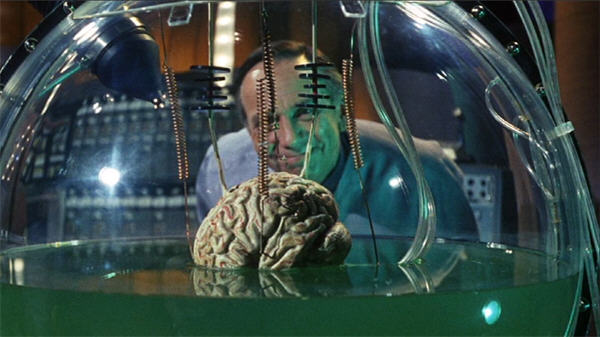
“I think I’ll call him… ‘Donovan’!”
This ending removes Project X from within the subgenre of apocalyptic science fiction, and categorises it instead as a mere cautionary tale—but even in that respect it has its peculiarities and failures. In fact, it puts me in mind of the speculative British film, Treason, from 1929, in that it similarly envisages a complete alteration of the existing world order, without giving the slightest hint of how such a situation came into existence. This makes it hard to take anything away from the overriding political scenario—except that in its own way, the West seems every bit as frightening as Sino-Asia.
It is what we gather from the screenplay’s smaller details about life in 2118 that Project X has an impact: the vision of government control, of lives spent without freedom of choice, of reproduction by permission—or the reverse. No-one in the film protests these realities; only the occasional nose-thumbing by Crowther and his team hint at rebellion. For the most part, however, the West’s grip on its people is as complete and as ruthless as that exerted by the “evil” Sinoese.
Lack of protest, indeed, is the very key-note of the film’s final sequence, in which the fate of Hagan Arnold is decided. Arnold’s own memory cannot be restored. Instead, as has been done in the past when memory-wiped secret agents have been recovered, he has been given a completely new matrix. He is now David Graham, engineer; he’s also married—to Karen Summers, as Crowther informs her after the event.
Karen sees nothing amiss in being married off without consultation to a man she barely knows—who has, in any event, had his mind and personality altered to one she doesn’t know at all. In fact, she’s delighted. After all, they’re both excellent physical specimens, and what else matters? They can get right down to the job of having their two permitted children…
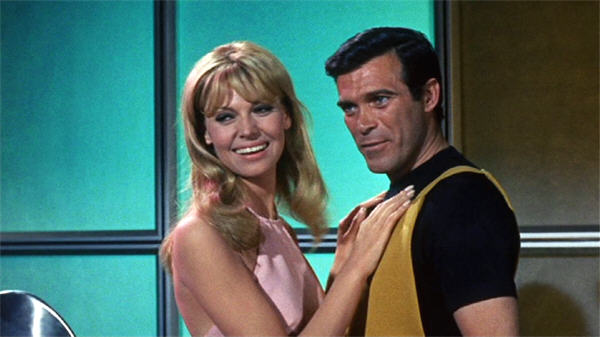
O brave new world, that has such ciphers in it…
Click here for more in Spinning Newspaper Injures Printer.
Click here for some Immortal Dialogue.
*****************************************************************************

This review is part of the B-Masters’ attempt to bring some overlooked films into the light.

Reblogged this on Mike's Movie & Film Review.
LikeLike
I’ve yet to watch this, perpetually turning to the channel it’s on fifteen or twenty minutes too late, and being too perplexed at what’s going on to stick with it. Now I think I’ll have to make an effort to find it… CURSE YOU!
LikeLike
My work here is done! 😀
Yes, you wouldn’t want to miss any of the explanatory stuff; the film is confusing enough with that!
LikeLike
I am completely unfamiliar with this one. Sounds interesting enough to hunt down. It sounds more like a horror movie, though, with the subconscious monster and the horrifying future.
LikeLike
Science fiction, horror, political thriller, action movie—it’s a complete hodge-podge, like Crash!, but the SF wins out in the end.
LikeLike
“Sinoese solve secret of chromatin in nucleus of cells”…
Hmmm…. From my brief research on the Internet about chromatin, it’s involved in cell division and which genes get expressed. My guess is that not only are the Sinoese breeding an army, but by controlling what genes get expressed in in embryonic development, they are making super-soldiers as well! Or at least people that are immune to whatever diseases Arnold is carrying. Clever!
LikeLike
I think you’re giving them FAR too much credit! 🙂
The problem with your theory is that it’s either too late or too early: the location and general function of chromatin had been understood for many years, while discovery of the more complex activities occurred over the following decades. There may have been enough research around the topic at the time to make “chromatin” a hot word, but the rider “in the nucleus of cells” suggests the writers didn’t really understand the topic.
LikeLike
“I WANT HIM IN THE GAMES UNTIL HE DIES PLAYING … a series of cardboard cut-out characters in low-budget sci-fi movies.”
LikeLike
Talk about cruel and unusual!
LikeLike
I’ve never heard of this film, and despite your cautions, it sounds fascinating. Alas, Netflix has never heard of it, and YouTube wants a whalloping $3 to see it! Amazon tells me it’s worth 4$ for a view….
LikeLike
I guess I won’t tell you what I paid for the DVD, then.
I think you’ll agree you get your $4.00 worth.
LikeLike
I read the L P Davies novel The Artificial Man when I was in high school, and found it hugely unnerving. Had no idea this movie existed, and by William Castle no less! Will have to look for Psychogeist now.
At least one other of Davies’s novels – Paper Dolls – was made into a movie, and now that I’ve remembered that, I have another thing to go looking for.
LikeLike
Hi – welcome!
I haven’t read any of Davies’ novels, though I am now keeping an eye out. I know his work is sometimes compared to Philip Dick’s.
LikeLike
Hi. This has nothing to do with anything, but it occurred to me that if you’re not already familiar with this movie that I happened across five minutes or so ago, you’d probably like to be: 🙂 Thanks for your time.
http://www.imdb.com/title/tt0073696/plotsummary?ref_=tt_ov_pl
LikeLike
Thanks for the thought, but those films often feature real snake killing, so I tend to avoid them on principle. If anyone can point me at one that doesn’t, though, I’d be all over it!
LikeLike
Hi again. I’d like to ask you a question unrelated to your site itself, but I don’t feel I should ask it publicly, and the link that offered to allow me to contact you privately didn’t, uh, work. I presume that, when I enter my Email (required), it allows you the ability to e-mail me directly, so if you’re ever THAT mind-numbingly bored, please feel free to initiate an e-mail exchange so I can ask my question. 🙂 Thanks for your time.
LikeLike
Site maintainer note: the href on the front page for “Contact Lyz directly here” should have a mailto: before the email address. That’s why it’s not working.
LikeLike
Thanks for bringing that to my attention. (You know how it is: update in haste, do it all over again at leisure…)
ETA: The front page link should be working now, please let me know if there are any further issues.
LikeLike
You may have seen an edited version of the movie. The ending I saw Had David and Karen leave. Then the camera pulls back to show that it was a projected scene for Galleia’s brain, still in the bowl. Dr. Crowther comments that it is amazing, he will tell them more dead, than he ever would alive. No word on the actual fate of poor Hagan Arnold, so we don’t know if they cured him, refroze him or simply incinerated him.
LikeLike
It isn’t a projected scene: the brain is in the lab next door, being probed and “telling” them things. “David” is Hagan Arnold with his new matrix installed: they couldn’t restore his own memories, so they wiped them and gave him a new identity.
LikeLike
Not in the version I have seen. The version I saw ends how I wrote, with Dr. Crowther gleefully looking at the brain in a bowl.
LikeLike